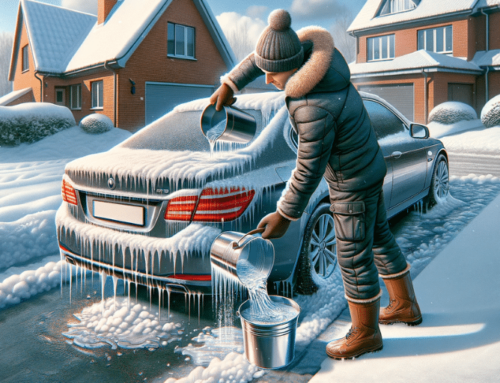How to Clean and Detail Your Car

Start by gathering car-specific cleaning products, microfiber towels, and a vacuum. Vacuum your car thoroughly, then clean leather seats, fabric seats, and wipe down the dashboard. For the exterior, pre-rinse to avoid scratches, wash using the two-bucket method, and scrub the tires with a dedicated bucket. Dry the car and wheels with microfiber cloths. Apply wheel cleaner and tire shine to detail the wheels. Finish by using a clay bar on the paint and apply protective coatings. Doing this will make your car shine like new and if you continue, you’ll discover more insider tips.
Gather Your Supplies
To begin detailing your car, you’ll need to gather essential supplies like car-specific cleaning products, microfiber towels, and a vacuum. These items will help you achieve a professional-level clean and make sure that every part of your vehicle looks its best. Start by collecting a complete car cleaning kit, which often includes everything you need for both interior and exterior detailing.
A bucket is important for mixing soapy water and rinsing your wash mitt. You’ll also want a wheel cleaner to tackle stubborn brake dust and grime on your wheels. For the windows, a quality glass cleaner will make sure you have streak-free visibility. Upholstery cleaner is essential for maintaining the fabric or leather surfaces inside your car.
Microfiber towels are a must-have because they’re gentle on your car’s paint and more effective at trapping dirt than traditional cloths. Consider organizing all your supplies in a portable caddy or tote, so you can easily access them as you move around your car.
Don’t forget to include a chamois for drying and a clay bar for paint prep to remove contaminants. With these products, you’re set to start detailing your car like a pro.
Clean the Interior
Start by thoroughly vacuuming the interior, including seats, floor mats, and hard-to-reach areas, to remove dirt and debris. Use the various attachments on your vacuum to get into all the nooks and crannies.
Once you’ve finished vacuuming, it’s time to use your car detailing supplies to tackle the rest of the interior.
Leather Seats and Surfaces: Apply a leather cleaner to a microfiber cloth and gently clean all leather surfaces. This will help preserve the material and keep it looking new.
Fabric Seats: For fabric seats, use a fabric cleaner that can lift stains and dirt without damaging the material. Spray the cleaner on, then scrub with a soft brush before wiping it off with a clean microfiber cloth.
Dashboard and High-Touch Areas: Disinfect high-touch areas like the steering wheel, door handles, and gear shift with a disinfectant wipe. Follow up by wiping down the dashboard, console, and interior windows with appropriate cleaners for a sparkling finish.
Important interior cleaning not only enhances your car’s appearance but also ensures a fresh and inviting driving environment. Don’t overlook this significant step in car detailing to keep your ride in top shape.
Wash the Exterior
After thoroughly cleaning the interior, it’s time to focus on washing the exterior to give your car a pristine look. Start by pre-rinsing the car to guarantee a scratch-free finish.
Use the two-bucket method: one bucket with car wash soap and water, the other with clean water for rinsing your car wash mitt. This technique minimizes the risk of transferring dirt back onto the car’s surface.
Pay special attention to bug splatter and grime that may be stuck on the front. For a more thorough clean, you can use an automotive clay bar after washing to lift any remaining contaminants. Rinse the car thoroughly to get rid of all soap residue.
When cleaning the tires and wheels, use a separate bucket to prevent transferring brake dust and grime to the car’s body. Use a foam applicator to apply car wash soap to the wheels and a tire and wheel cleaner for extra detailing.
Finish by drying the car with a clean microfiber cloth to avoid water spots. Finally, use an ammonia-free glass cleaner for the windows and mirrors to complete the exterior detailing. This ensures your car looks spotless and well-maintained.
Detail the Wheels
Detailing the wheels is essential for achieving a truly polished look for your car. Start by applying a dedicated wheel cleaner to tackle brake dust and grime effectively. This specialized cleaner penetrates tough residues that regular soap can’t handle.
Next, use a wheel brush to scrub the wheels, paying extra attention to crevices and corners. For a thorough cleaning, follow these steps:
- Apply wheel cleaner: Spray it generously on the wheels and let it sit for a few minutes.
- Scrub with a wheel brush: Work the cleaner into all the nooks and crannies, making sure no spot is missed.
- Rinse wheels thoroughly: Use a hose to remove all cleaner residue, preventing streaks and spots.
Once the wheels are clean, it’s important to dry them with a microfiber cloth. This step prevents water spots and ensures a spotless finish.
After drying, apply a quality tire shine product to enhance the tire appearance. This final touch not only makes the tires look great but also provides a layer of protection.
Protect and Shine
To keep your car looking its best, protect its exterior with high-quality surface coatings that shield against UV rays and contaminants. Start by using a clay bar to prep the car paint. The clay bar will remove any embedded contaminants, leaving the surface smooth and ready for the protective coatings. This step is important for achieving a glossy shine.
Before moving on to the body, make sure your wheels are spotless. Use a quality wheel cleaner to remove brake dust and grime effectively. Regular washing is essential to maintain your car’s appearance and protect its paint. Use proper tools like microfiber towels and mitts to avoid scratches and ensure immaculate results.
Once your car is clean, apply the surface coatings. These coatings create a barrier that not only enhances the shine but also protects against UV rays and other harmful contaminants. Don’t skip this step if you want long-lasting protection and a mirror-like finish.
Frequently Asked Questions
What Is the Proper Way to Wash and Detail a Car?
To properly wash and detail a car, start with the wheels. Use the two-bucket method to wash, detail with clay, and apply spray wax. Regular washing with quality products maintains appearance and value.
How to Clean Your Car Like a Professional?
To clean your car like a professional, start with a thorough exterior wash. Use a clay bar for decontamination, then polish and wax. Inside, vacuum, use detailing brushes, and protect surfaces for that showroom finish.
How to Detail Your Car in Order?
Start by gathering supplies, then pre-rinse and wash the exterior. Dry it thoroughly. Move to the interior, vacuum and scrub carpets, clean surfaces, and disinfect. Finish with tire shine, trim restorer, and polish.
How to Do Car Detailing Yourself?
You can detail your car yourself by gathering car-specific tools, allocating ample time, and following a systematic process from the interior to the exterior. Regular detailing maintains your car’s value and makes future cleanings easier.
How Often Should You Fully Detail Your Car?
You should fully detail your car at least twice a year. Factors like driving conditions and weather might require more frequent detailing. Regular deep cleaning prevents dirt buildup, removes stains, and prolongs your car’s interior and exterior life.
Conclusion
You’ve done it! With your supplies gathered and each step carefully followed, your car now looks fantastic inside and out.
By cleaning the interior, washing the exterior, detailing the wheels, and adding a protective shine, you’ve not only improved your car’s appearance but also its longevity.
Regular maintenance like this keeps your vehicle in top shape, making every drive more enjoyable.
So, keep up the good work, and enjoy the pride of driving a well-kept car!



